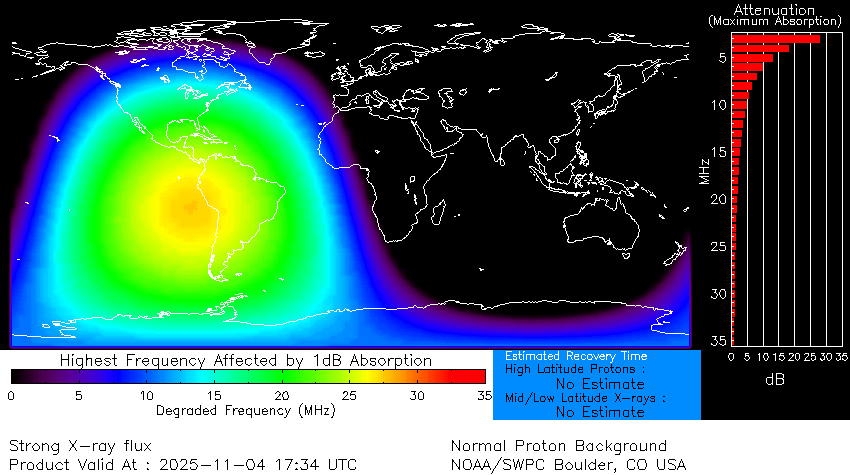UPDATED - For older posts, please scroll down
UPDATE 10 November 2025 at 12:30UTC - FAST WARNING 'PRESTO' MESSAGE from the SIDC (RWC-Belgium): "An X1.2 solar flare (SIDC Flare 6010) peaked at 09:19 UTC on November 10 and originated from SIDC Sunspot Group 687 (NOAA active region (AR) 4274). The region, located at N24 W15, has a beta-gamma-delta magnetic configuration and a McIntosh Ekc classification. Given its large size, complexity, and recent intense activity, including an X-class flare on 09 November 2025, additional significant flares remain possible. In the next few hours we will know whether a coronal mass ejection was associated with this event. Further details will follow as coronagraphic data become available."
The flare was a long duration event (lasting more than 1 hour) and is associated with an ongoing proton event protons with energies of 10 MeV or more) that started at 11:25 UTC (GOES). The flux of protons with energies of 100 MeV or more is currently still at background levels. A view on the eruption as seen in H-alpha (a line in the red portion of the solar spectrum; GONG) can be found underneath. Just as the X-class event yesterday, it seems to be triggered by a filament instability north of the main (trailing spot).
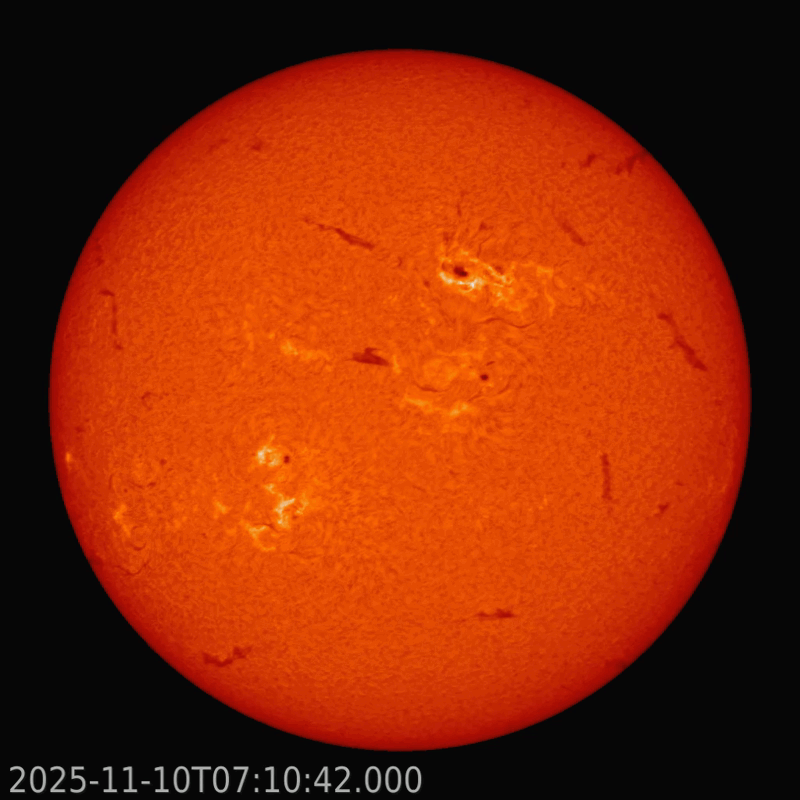
Radio bursts were detected by the radio astronomy station at Humain (HuRAS), recording Type II, Type III and Type IV radio bursts (see the STCE SWx Classification page) , as shown in the radio spectrogram underneath with the horizontal axis representing time and the vertical axis representing frequency (lowest frequencies on top). The top chart represents the evolution of the soft x-ray flux as recorded by GOES. The intensity of the radio bursts was very pronounced at lower ultrahigh frequencies (UHF ; 300 - 3000 MHz), the burst peaking at 130.000 sfu (610 MHz) and 2100 sfu at GNSS frequencies (1415 MHz ; NOAA/USAF). The intensity at the latter frequency was weaker than during yesterday's X-class flare.
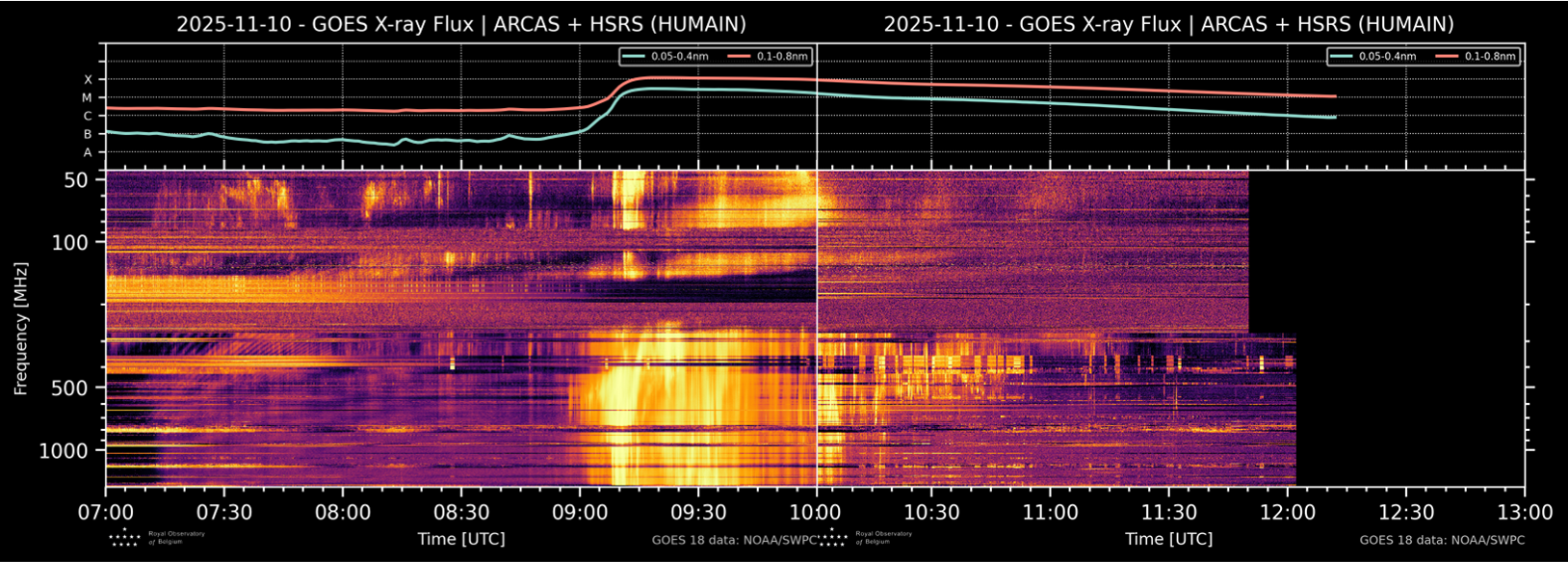
Following the analysis of the associated Type II and Type IV radio bursts, a coronal mass ejection with a shock speed near 1300 km/s was associated with this eruption (NOAA/USAF). The CME itself was also much faster than yesterday's CME, resp. near 700 and 1100 km/s plane-of-the-sky speed. STEREO-A's coronagraphic images clearly show an earth-directed CME. It remains to be seen when exactly this CME will arrive at the earth environment, and if it will catch up with yesterday's slower CME, currently expected to arrive early on 12 November. Standing-by further analysis by the SIDC SWx forecaster.
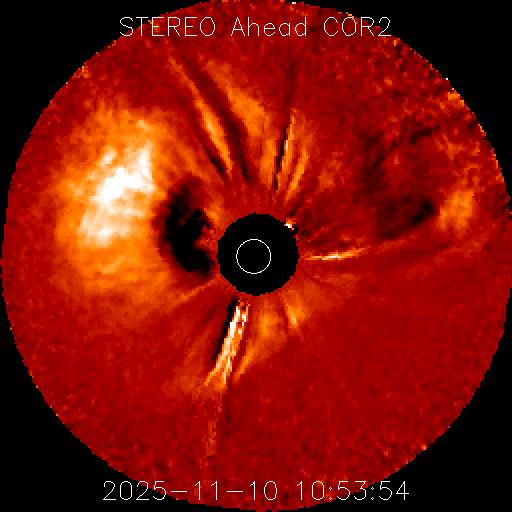
The X-class flare affected the lower frequency portion of the High Frequency communication band (HF Com ; 3 - 30 MHz) on the dayside of the Earth, mainly over the western portion of the Indian Ocean and South-East Africa. An advisory to civil aviation has been issued (PECASUS). The ongoing proton event may (mildly) affect the HF communications over the polar regions, in particular over Antarctica. The effects of the X1 flare and the proton event on HF Com can be seen in the D-RAP maps underneath (NOAA/SWPC).

UPDATE 9 November 2025 at 09:45UTC - Active region NOAA 4274 (SIDC Sunspot Group 687) produced its second X-class flare early this morning. Following the SIDC's PRESTO alert, "An X1.7 flare was detected in the GOES 19 X-ray flux data peaking at 07:33 UTC on November 09. The flare is associated with SIDC Sunspot Group 687 (NOAA Active Region 4274). The greater than 10 MeV GOES proton flux has remained at background levels. Further M-class flaring can be expected from this region with a chance for another X-class flare." Interestingly, the flare took place slightly to the east of the trailing portion of NOAA 4274, not over the much more complex and dynamic leading portion. This is shown in the SDO/AIA 131 and GONG white light combo underneath, taken around 07:30UTC, i.e. close to the flare's peak time. The diffraction patterns in the EUV images are image artifacts, and are not related to the flare itself - See this STCE newsitem for more info. High Frequency (HF) communications have been disturbed over the daylight side of the Earth (D-RAP; Map), in particular over the Indian Ocean. Advisories for disturbed HF Com have been sent to the civil aviation by PECASUS.
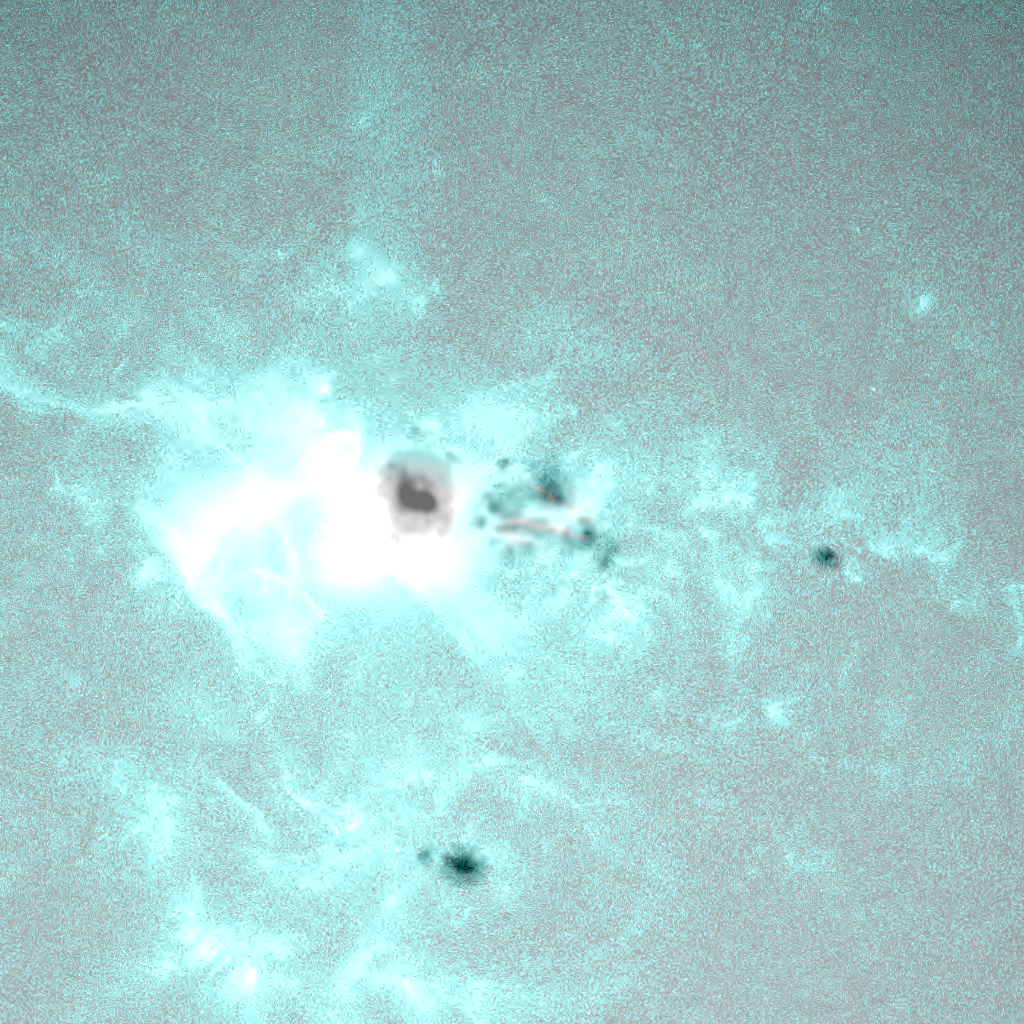
Following the analysis of the associated radio bursts, a coronal mass ejection with a shock speed near 800 km/s was associated with this eruption (NOAA/USAF). In view of NOAA 4274's location close to the central meridian, it's very likely that (a portion) of this CME is earth-directed. Standing-by the analysis by the SIDC SWx forecaster. The radio burst was also detected by the radio astronomy station at Humain (HuRAS), recording Type II, Type III and maybe also Type IV radio bursts (see the STCE SWx Classification page) , as shown in the radio spectrogram underneath with the horizontal axis representing time and the vertical axis representing frequency (lowest frequencies on top). Note some interference effects from the sunrise. The top chart represents the evolution of the soft x-ray flux as recorded by GOES. A better view on the Type II and Type III bursts is provided in the Learmonth radio spectrogram (note the reversed vertical axis, with the highest frequency on top). The radio bursts were very pronounced at lower ultrahigh frequencies (UHF ; 300 - 3000 MHz), the burst peaking at 120.000 sfu (610 MHz) and 12.000 sfu at GNSS frequencies (1415 MHz ; NOAA/USAF). This intensity may have caused some communication problems at these frequencies.

UPDATE 4 November 2025 at 22:45UTC - The Sun produced a second X-class flare, just a few hours after the X1.8 event discussed underneath. The X1.1 flare peaked at 22:01 UTC. However, it did NOT have NOAA 4274 as its source, but rather an active region just behind the southeast solar limb as can be seen in the GOES/SUVI images below showing the flare in extreme ultraviolet (EUV) near its peak time: left at temperatures around 80.000 degrees, and on the right at temperatures of several million degrees. The diffraction patterns in the EUV images are image artifacts, and are not related to the flare itself - See this STCE newsitem for more info. A proton event from this eruption is unlikely due to its location, and any associated coronal mass ejection (CME) is very likely not earth-directed. More information will be given by the SIDC forecaster as the region rotates over the east limb.
The X-class flare affected the lower frequency portion of the High Frequency communication band (HF Com ; 3 - 30 MHz) mainly over the Pacific Ocean and New-Zealand. The effects of the X1 flare on HF Com can be seen in this D-RAP map (NOAA/SWPC). An advisory to civil aviation has been issued (PECASUS).
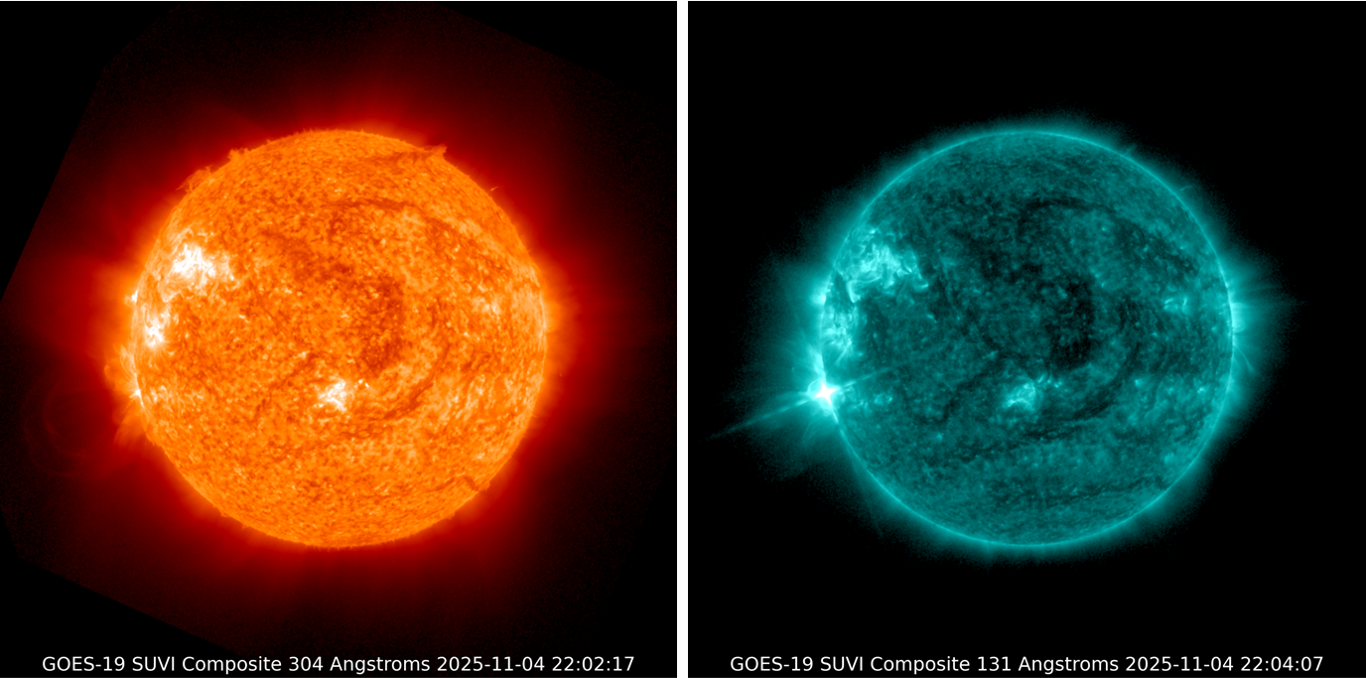
Original 4 November 2025 at 20:45UTC - Active region NOAA 4274 (SIDC Sunspot Group 687) is the return of the flare-productive NOAA 4246. That region was the source of 27 M-class flares which it produced during its transit over the solar disk from 10 to 19 October (see this STCE newsitem). While it was on the Sun's far side, it continued to produce strong eruptions, based on the numerous coronal mass ejections (CMEs) that were observed. Those were obviously directed away from the Earth. But now that active region has returned again and it is still very active: It has gotten a new number, but has clearly retained its old habits as it has just produced an X-class flare.

This eruption registered as an X1.8 that peaked at 17:34 UTC on 4 November (GOES). The SDO images above show NOAA 4274 in white light (left) as well as its complex magnetic structure (right; white denotes field lines coming out of the solar surface, black represent magnetic field lines returning to the Sun). The region harbors a delta structure (see the Mount Wilson classification) which in combination with the relatively large size of the region, can produce very strong flares. The GOES/SUVI images below show the flare in extreme ultraviolet (EUV) near its peak time: left at temperatures around 80.000 degrees, and on the right at temperatures of several million degrees. The diffraction patterns in the EUV images are image artifacts, and are not related to the flare itself - See this STCE newsitem for more info.
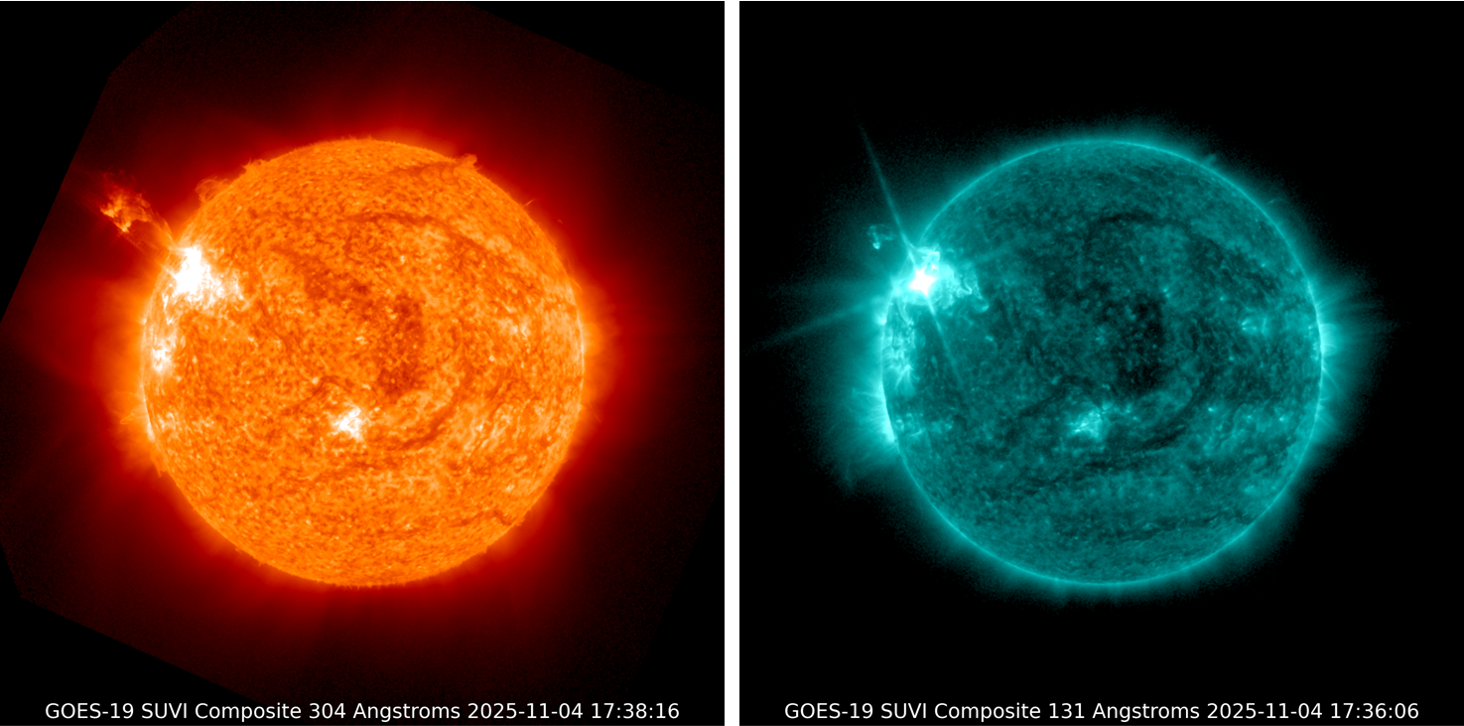
Coronagraphic images by STEREO-A -which is now leading the Earth by about 49° (map)- shows a relatively fast and wide CME, with a preliminary speed around 800 km/s and a width of around 100°. In view of the location of NOAA 4274 on the solar disk, this suggests that there's a small chance the earth environment may receive a glancing blow from this CME, albeit a nearby coronal hole (SolarMap) may divert it further away from Earth. Further analysis and images by the SOHO/LASCO coronagraphs are necessary before the SIDC SWx forecaster can make a final decision. Stand-by for updates.
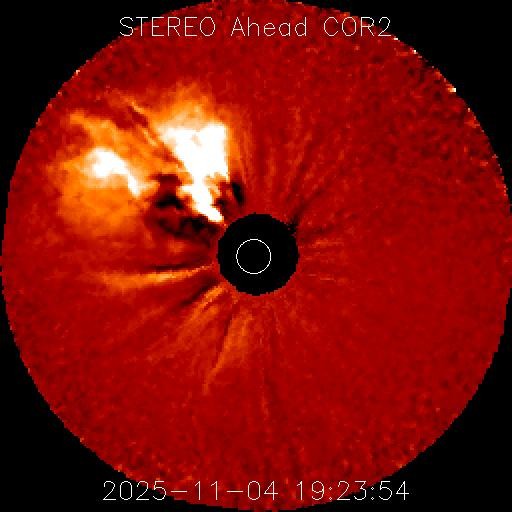
No proton event has been observed yet, with the greater than 10 MeV proton flux remaining close to background levels (GOES). Mild enhancements of the radio flux at various frequencies have been observed (NOAA/USAF). Also the 10.7cm solar radio flux at 18UTC was affected, being nearly 40% above its value from the preceding days (Penticton, Canada; 183 sfu compared to 133 sfu). The radiospectrogram underneath was obtained by an eCallisto station in Mexico and shows strong Type III radio bursts between 17:24 and 17:28UTC. The Type II and Type IV bursts are not so obvious, if any (see the STCE SWx Classification page). Note that the bandwidth of this station is quite narrow, spanning only about 40 MHz. The horizontal axis represents time (from 17:14 to 17:59 UTC), the vertical axis is the frequency, with the highest values on top. The flare started (in soft x-rays) at 17:15 UTC, peaked at 17:34 UTC, and ended at 17:51 UTC.

The X-class flare affected the lower frequency portion of the High Frequency communication band (HF Com ; 3 - 30 MHz) mainly over South-America and the eastern portion of the Pacific Ocean. The effects of the X1 flare on HF Com can be seen in the D-RAP map underneath (NOAA/SWPC). An advisory to civil aviation has been issued (PECASUS). In view of its current size and complex magnetic structure, NOAA 4274 is likely to produce more strong flares during the next few days.
